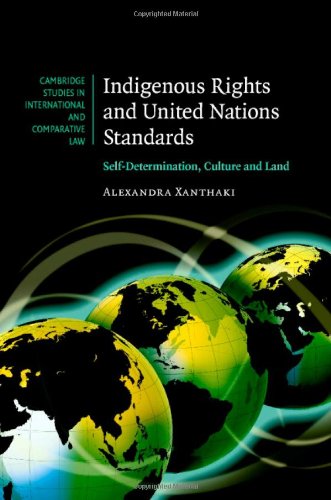Alexandra Xanthaki0521835747, 9780521835749, 9780511275098
Table of contents :
Half-title……Page 3
Series-title……Page 4
Title……Page 5
Copyright……Page 6
Contents……Page 7
United Nations Human Rights Committee……Page 10
Australia……Page 11
United States……Page 12
Conventions and Treaties……Page 13
UNESCO:……Page 14
Declarations……Page 15
Resolutions (other than the above)……Page 17
Recommendations and other non-binding documents……Page 18
Commission Drafting Group/WGIP/other indigenous fora:……Page 19
CERD (Committee for the Elimination of Racial Discrimination):……Page 24
Economic, Social and Cultural Rights Committee:……Page 25
Human Rights Commission:……Page 26
Human Rights Committee:……Page 27
UNESCO:……Page 29
Conventions/Declarations……Page 30
Recommendations……Page 32
Requests, Observations and Reports……Page 33
Other international instruments……Page 36
Europe……Page 37
Indigenous Organisations’ documentation……Page 38
Philippines……Page 39
Vietnam……Page 40
Acknowledgments……Page 41
Introduction……Page 43
Notes……Page 52
The importance of cultural membership……Page 55
Autonomy and the neutral state……Page 57
The need for multiplicity of cultural frameworks……Page 61
Interaction of cultures……Page 64
Preservation of cultures……Page 69
Especially on collective rights……Page 71
Concluding comments……Page 80
Notes……Page 81
PART I United Nations instruments on indigenous peoples……Page 89
The ILO and indigenous peoples……Page 91
Definition……Page 94
Integration……Page 95
Protection of indigenous rights……Page 98
Control over indigenous affairs……Page 101
Land rights……Page 102
Recruitment and conditions of employment……Page 106
Education and languages……Page 107
Concluding comments……Page 108
Procedure of the revision……Page 109
Basic orientation of Convention No. 169……Page 110
Identification of the beneficiaries……Page 112
Collective rights……Page 115
Protection of indigenous rights and cultures……Page 116
Participation, co-management and self-government……Page 118
Land rights……Page 122
Recruitment, conditions of employment and vocational training……Page 130
Concluding comments……Page 132
Notes……Page 134
3 Emerging law: The United Nations draft Declaration on indigenous peoples……Page 144
Process and status of the draft Declaration……Page 145
Peoples, membership, self-identification, nomadic peoples……Page 147
Individual and collective rights……Page 149
Self-determination……Page 151
Protection of indigenous peoples……Page 154
Cultural and linguistic identity……Page 157
Land and resources……Page 159
Concluding comments……Page 161
Notes……Page 163
PART II Thematic analysis……Page 171
Introduction……Page 173
The issue……Page 174
No clear recognition of indigenous as ‘peoples’ in international law……Page 175
Employment of the definition of ‘peoples’ in international law……Page 177
Employment of international documents……Page 178
The hurdle of territorial integrity……Page 182
The minimalist approach: self-determination as independence……Page 188
The maximalist approach: self-determination as an umbrella right……Page 194
Self-determination is a right and a principle……Page 197
The political core of the right to self-determination……Page 199
Internal aspect of indigenous self-determination……Page 202
External aspect of indigenous self-determination……Page 208
Emerging applications of the right to self-determination……Page 211
Concluding comments……Page 215
Notes……Page 218
Introduction……Page 238
General standards……Page 239
Minority standards……Page 242
Collective element……Page 243
Positive protection……Page 244
Culture as capital……Page 246
Culture as creativity……Page 247
Culture as way of life……Page 249
The concept of cultural property……Page 251
Ownership of culture……Page 253
Specific issues concerning cultural rights……Page 256
Indigenous cultural autonomy……Page 257
Misappropriation and misuse of indigenous cultural heritage……Page 259
Repatriation of indigenous cultural objects……Page 263
Indigenous biodiversity rights……Page 266
Notes……Page 269
Introduction……Page 279
Legal basis for indigenous land claims……Page 280
Doctrine of terra nullius……Page 285
Non-recognition of ownership……Page 286
Recognition of individual ownership……Page 287
Native title……Page 288
Problems of proof……Page 291
Rights of consultation and participation……Page 294
Rights of use, management and resources……Page 298
Removal and relocation……Page 304
Restitution and compensation……Page 306
Concluding comments……Page 309
Notes……Page 310
Conclusions……Page 322
Notes……Page 327
Bibliography……Page 328
Index……Page 348

Reviews
There are no reviews yet.